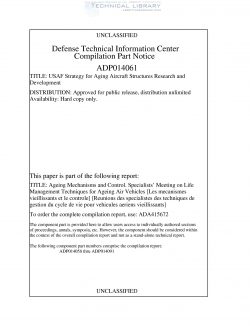DTIC-AD-P014061
- Version
- 262 Downloads
- 1.33 MB File Size
- 1 File Count
- March 5, 2017 Create Date
- March 5, 2017 Last Updated
USAF Strategy for Aging Aircraft Structures Research and Development

Many nations are now keeping aircraft in their inventories longer than ever before. In many cases, aircraft are left in the inventory longer because they are still operationally effective; however, in most cases, they remain in the inventory because the money is not available to replace them. Aircraft, which are seeing the effects of aging through corrosion and fatigue cracking, are causing their operators to bear a significant economic burden to keep them operational With the potential for degradation of flight safety of aging aircraft if they are not maintained properly. The United States Air Force (USAF) has maintained safety of their aircraft for the last thirty years through the application of damage tolerance principles to determine inspection intervals. This approach has on occasion been modified because of the onset of widespread fatigue damage (WFD) or the loss of material because of corrosion. In the case of WED, the USAF has developed a modification program to alleviate the problem. In the event of corrosion damage, both modification and reduced inspection intervals have been used. The USAF has developed a strategy for the sustainment of their aircraft starting with the identification of user needs requiring research and development efforts. The strategy is based on identifying research and development opportunities that will have a favorable return on the investment through cost savings or cost avoidance and increased aircraft availability. This has presented problems since it is difficult to determine the cost of maintaining aircraft in enough detail to determine the return on the investment accurately. To date, identified activities include improvements in nondestructive inspection capability, corrosion tracking and prevention techniques, and advances in repair of metallic structures through composite patching. In addition, improved materials for substitution and environmentally compliant coatings have been identified. The purpose of this paper is to provide a discussion ofthe aging concerns found in the structure of USAF aircraft and the approach the USAF is pursuing to alleviate these concerns.
| File | Action |
|---|---|
| DTIC-AD-P014061 USAF Strategy for Aging Aircraft Structures Research and Development.pdf | Download |

Comment On This Post